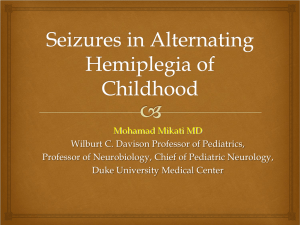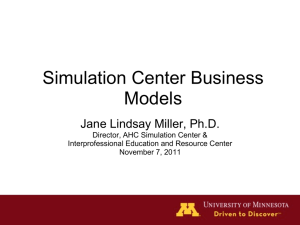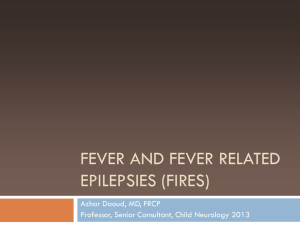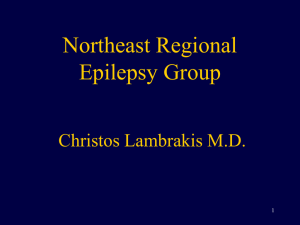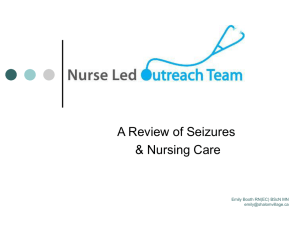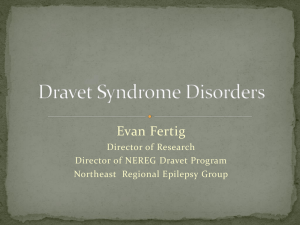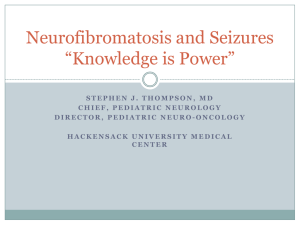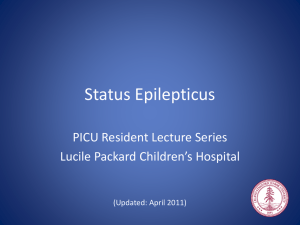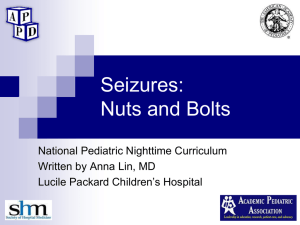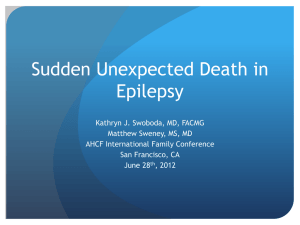Dr Mohamad Mikati - International Foundation for Alternating
advertisement
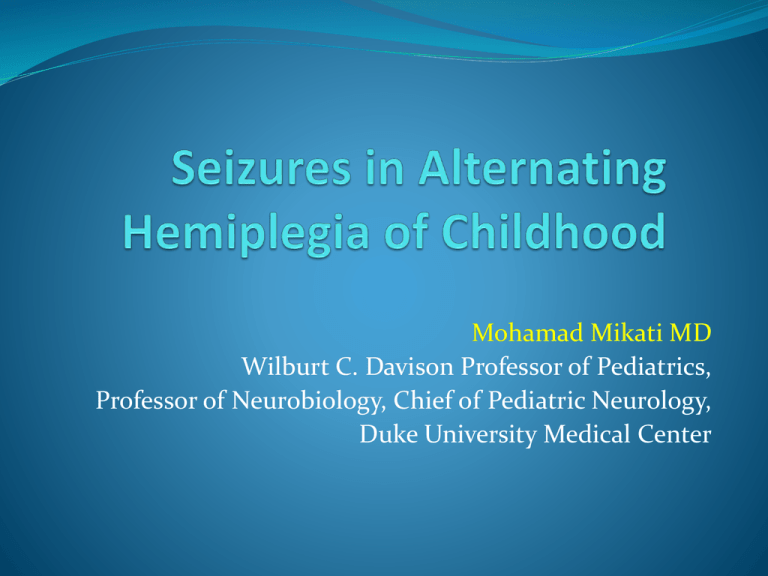
Mohamad Mikati MD Wilburt C. Davison Professor of Pediatrics, Professor of Neurobiology, Chief of Pediatric Neurology, Duke University Medical Center Milestones in AHC and Parallels with Epilepsy Defining the Syndrome: Verret and Steele, 1971 Casaer and Azou, 1984 Aicardi, 1987 Registries: Mikati et al, 2000 Sweney et al 2009, Panagiotakaki et al 2010 Genetics: Mikati et al, 1992 Foundations Swoboda et al, 2004 USA (families/M. Mikati 1993) Bassi et al, 2004 Other countries France (families/J. Aicardi, 1992) Outline Distinction Between Seizures and AHC spells Studies of Seizures in AHC Therapy Epileptic Seizures Occurrence of signs and/or symptoms due to abnormal excessive or synchronous neuronal activity Normal EEG: EEG During Epileptic Seizures Focal Ictal Discharge Generalized Discharges EEG Changes Interictally Focal Discharges Generalized Discharges Abnormal Movements Basal ganglia Dystonic/tonic Choreoathetosis tremor Brain stem Nystagmus Cerebellar Ataxia tremor Video Illustrations Epileptic Hemiplegia focal epileptic seizure starting with dystonia like movement, the generalized stiffening then focal weakness. Epileptic Dystonic seizure Epileptic Tonic seizure Dystonia in a case of AHC Hemiplegia in a case of AHC Myoclonic seizure in a case of AHC Epileptic Hemiplegia Video here Epileptic Dystonia Video here Epileptic Tonic Seizure Video here AHC Case: Baseline EEG Dystonia in AHC Video here. AHC Case: EEG in Dystonia Hemiplegic Spell in AHC Video here. AHC Case: EEG in Hemiplegia EEG During Hemiplegia in Patient with AHC (A) Patient 1 during right hemiplegia at age 3 years (B and C) Patient 3 at age 11 months, during right hemiplegia (B) and after resolution of hemiplegia (C) Saito, Y. et al., Epilepsy Research 2010: 90; 248-258 Myoclonic Seizures Video here. AHC Case: EEG of Myoclonic Jerks EEG During Epileptic Seizure in AHC Ictal EEG. Seizures were captured as frequent, jerky awakenings from sleep, followed by unilateral attacks with a slow, forced deviation of the head and eyes to the right or the left side accompanied by an ipsilateral tonic extension of the arm and the leg which lasted for a few minutes. They sometimes lasted longer; -i.e. up to 15 minutes when the tonic posturing could become global Saltik S. et al., Epileptic Disorders 2004: 6; 45-48 Outline Distinction Between Seizures and AHC spells Studies of Seizures in AHC Therapy Mikati Study We studied 44 patients 8/44 (19%) fit the strict criteria requiring consistent EEG, ictal or interictal, Not considered epileptic: Many other patients with tonic episodes who though responding to IV Diazepam failed subsequent antiepileptic drug treatment without video EEG monitoring Mikati et al., Pediatric Neurology 2000: 23(1);134-141 Frequency of Seizure Activity 8/44 patients (19%) experienced seizures sometime in their life 4 had infrequent seizures (50%) with a total of 3 or fewer seizures each 4 had frequent seizures (50%) with one having history of status epilepticus 4 had generalized tonic clonic 3 focal and one myoclonic seizures Mikati et al., Pediatric Neurology 2000: 23(1);134-141 Sweney Study 44/103 (43%) were reported to have epilepsy Occurrence of generalized tonic or tonic-clonic seizures with altered consciousness considered seizures, other seizure types Mean age of onset 6 years Most, 34, (77%) were reported to have onset < age 10 years Focal and generalized seizures and EEG findings reported Sweney M et al Pediatrics 2009; 123:e534-e541 Panagiotakaki Study: Frequency of Seizures with Age Cohort with > 24 year FU * * * 53% had seizures, 52-75% depending on age were controlled Panagiotakaki E et al., Brain 2010: 133; 3598-3610 Other Seizure Manifestations Neonatal onset 12.5% of patients, 3 % first day Presumed Gelastic seizures in 3% Aura of irritability, dysethesias of limbs and throat or body Sudden unexpected death (7/157) 3 with seizures, 2 with plegia, one cardiovascular failure and one unknown, these patients did not have more severe spells but were more disabled Seizures may sometimes occur with plegic/dystonic attacks and focal epilepsia parialis continua can occur Panagiotakaki E et al., Brain 2010: 133; 3598-3610 Neville and Ninan Dev Med child Neurol 2007;49:777-80: Saito Study: Frequency Retrospective review of clinical information on 9 patients (age: 4-40 years), seven/nine thought to have epilepsy. Presumptive epileptic seizures in seven patients Age of onset ranging from 2 – 16 years Saito et al., Epilepsy Research 2010: 90; 248-258 Saito Study: Types of Seizures Tonic Tonic with cyanosis, nystagmus, twitching of face and extremities, clonic, cyanosis Cyanosis Tonic, Eyelid twitching, cyanosis Tonic, upward gaze, tonic Generalized tremor, myoclonus, Blinking, twitching of face and extremities, clonic movements, cyanosis Ocular deviation, clonic/myoclonic, post-ictal respiratory arrest Sudden fall, nystagmus, generalized clonic, cyanosis Generalized tonic-clonic seizure Generalized seizures Febrile seizures Saito et al., Epilepsy Research 2010: 90; 248-258 Neonatal Onset Seizures Four patients with neonatal disease onset showed: Lower psychomotor developmental achievements Repeated status epilepticus followed by progressive deterioration MRI – brain atrophy cerebellar and hippocampal high signal changes Saito et al., Epilepsy Research 2010: 90; 248-258 MRI in Patients with Status Saito et al., Epilepsy Research 2010: 90; 248-258 Outline Distinction Between Seizures and AHC spells Studies of Seizures in AHC Therapy Acute Seizures First Aid (positioning, breathing, etc..) Rescue medications (usually benzodiazepines) Awareness of and response to apnea Awareness of and response to status epilepticus Antiepileptic Drugs Focal Seizure: Carbamazepine, Oxcarbazepine, Levetiracetam, Topiramate, other Generalized and Myoclonic Seizures: Valproate, Clonazepam, Levetiracetam, Topiramate, other Frequent follow up and reevaluations to distinguish epileptic seizures from other episodes and to consider alternative therapies is needed. Conclusions Dystonic/tonic and hemiplegic spells are difficult to distinguish from epileptic seizures but detailed history, interictal EEG, and Video EEG help distinguish them from the multiple seizure types At least ½ are well controlled and some have difficult seizures including neonatal onset, apnea, status epilepticus. Therapy of epilepsy in AHC is similar to that of epilepsy without AHC with modifications based on the occurrence of the above findings Conclusions Our increasing knowledge is improving our ability to help AHC patients and has increased our hopes for major discoveries in the future Thank you for your attention
